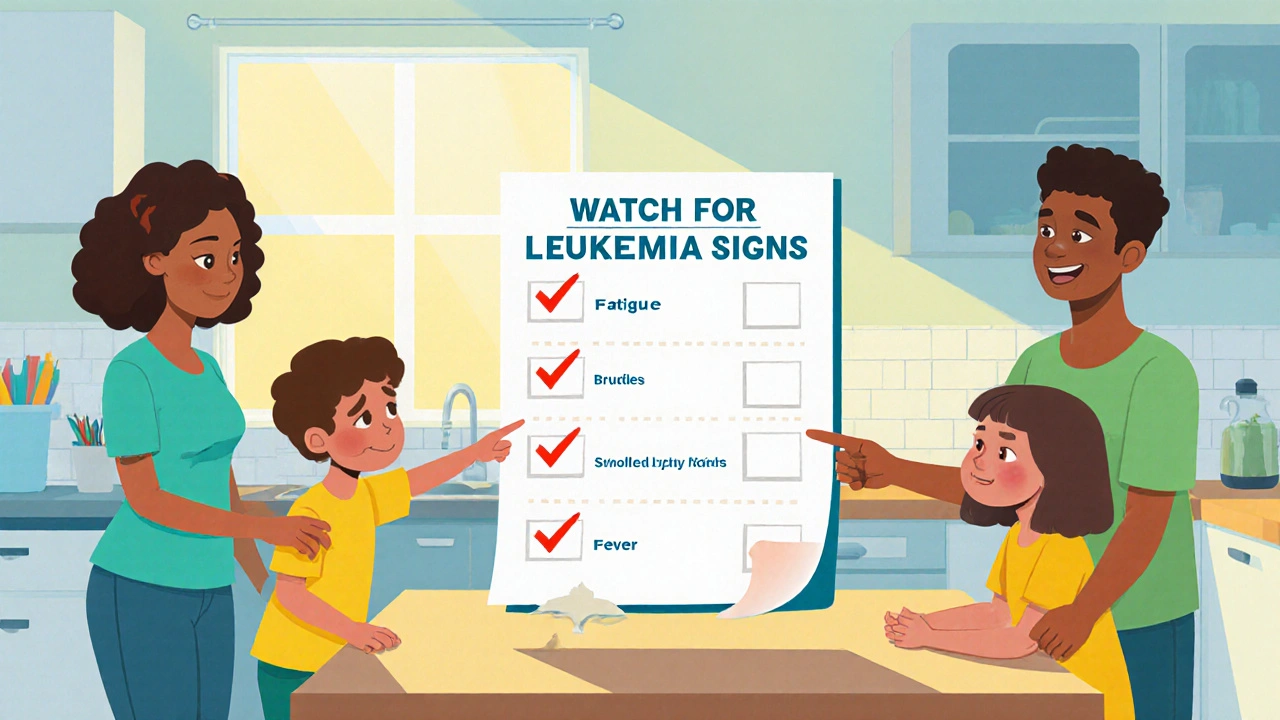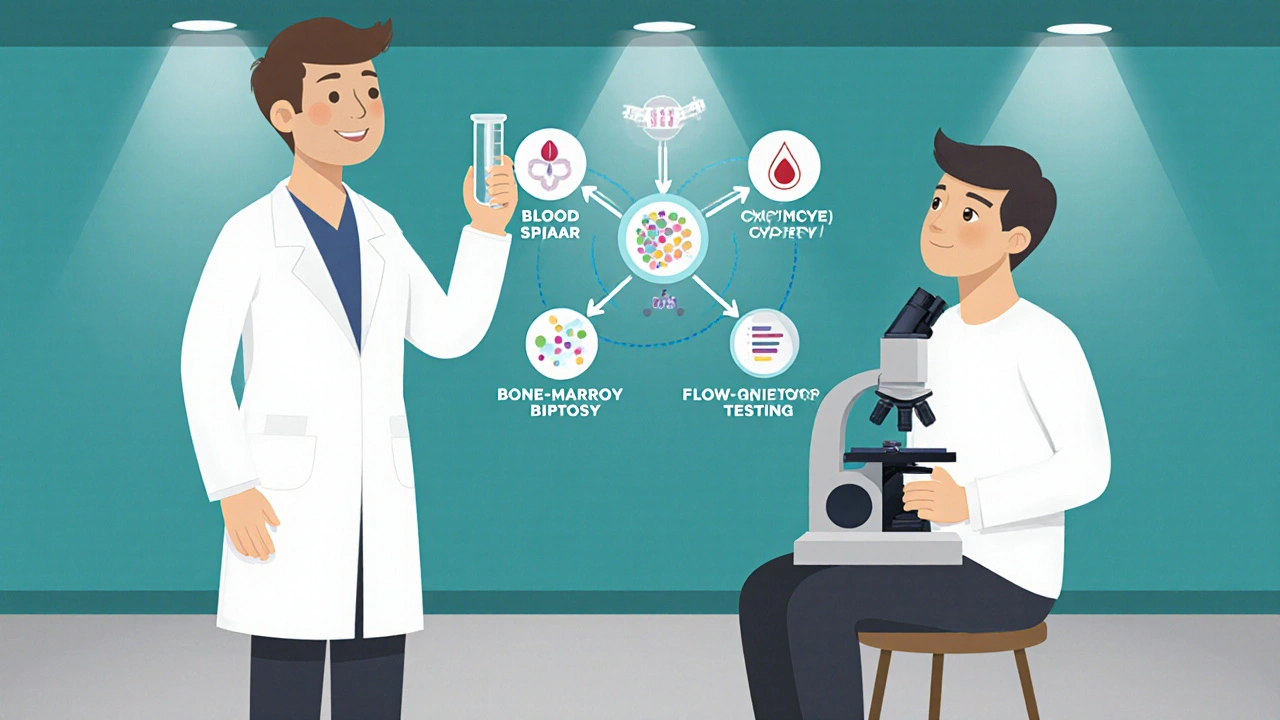Early Detection in Leukemia: Critical Signs You Should Know
 Oct, 22 2025
Oct, 22 2025
Leukemia Early Detection Symptom Checker
This tool helps you understand if your symptoms might indicate the need for medical evaluation. It is not a diagnostic tool and should not replace professional medical advice.
Based on the article, combinations of symptoms are more significant than single occurrences. Look for persistent symptoms over 2-3 weeks.
Symptom Selection
Risk Assessment
Select your symptoms to see your risk level
Spotting leukemia early can be the difference between a quick, effective treatment and a tough battle. This guide breaks down the most common warning signs, explains how doctors confirm the disease, and offers practical steps you can take to stay ahead of the curve. Keep reading to learn what to watch for and why early detection leukemia matters.
What Is Leukemia?
Leukemia is a type of blood cancer that starts in the bone marrow, where blood cells are made. It causes the production of abnormal white blood cells that crowd out healthy cells, leading to a range of health problems. The disease comes in many forms, but the two most common categories are acute and chronic, each with distinct behavior and treatment approaches.
Key Types of Leukemia
Acute Lymphoblastic Leukemia (ALL) is the most frequent childhood leukemia, producing immature lymphocytes that grow rapidly. Chronic Myeloid Leukemia (CML) typically appears in adults and involves the uncontrolled growth of mature myeloid cells. Both types derail normal blood formation, but they differ in speed, age of onset, and genetic markers.
Why Early Detection Matters
Detecting leukemia before it progresses offers several life‑saving advantages:
- Higher cure rates: Early‑stage disease responds better to chemotherapy, targeted therapy, or bone‑marrow transplant.
- Fewer complications: Treating before anemia, infections, or bleeding become severe reduces hospital stays.
- More treatment options: Some targeted drugs are only approved for early‑stage patients.
- Better quality of life: Early intervention often means less aggressive therapy and quicker return to normal activities.

Warning Signs You Shouldn't Ignore
Leukemia symptoms can mimic common illnesses, which is why paying attention to patterns is crucial. Look out for these persistent clues:
- Unexplained fatigue or weakness that doesn't improve with rest.
- Frequent infections or slow healing of cuts, indicating a weakened immune system.
- Unusual bruising or bleeding, such as nosebleeds, gum bleeding, or red spots (petechiae) on the skin.
- Persistent fever or night sweats without an obvious cause.
- Bone or joint pain, especially in the long bones of the arms and legs.
- Swollen lymph nodes, often felt as painless lumps in the neck, armpits, or groin.
- Enlarged spleen or liver, causing a feeling of fullness or discomfort in the left upper abdomen.
- Unexpected weight loss despite normal eating habits.
When several of these signs appear together, especially in a short time frame, it’s a red flag that warrants medical evaluation.
How Doctors Confirm the Diagnosis
Diagnosing leukemia involves a series of tests that examine blood and bone‑marrow cells. The typical pathway looks like this:
- Complete Blood Count (CBC) is the first screen, measuring white blood cells, red blood cells, and platelets. Abnormal counts-high or low white cells, anemia, or thrombocytopenia-raise suspicion.
- A peripheral blood smear is examined under a microscope to spot immature cells (blasts) that shouldn't be circulating.
- If the CBC points to a problem, a bone‑marrow biopsy is performed. The sample reveals the proportion of blasts and the overall health of the marrow environment.
- Specialized labs use flow cytometry to tag cells with fluorescent antibodies, identifying the exact lineage (lymphoid vs myeloid) of the abnormal cells.
- Genetic testing, including PCR and next‑generation sequencing, looks for hallmark mutations (e.g., BCR‑ABL1 in CML or TEL‑AML1 in ALL) that guide targeted therapy.
These steps together provide a precise picture of the disease, allowing doctors to classify the type, stage, and best treatment plan.
ALL vs. CML: A Quick Comparison
| Feature | Acute Lymphoblastic Leukemia (ALL) | Chronic Myeloid Leukemia (CML) |
|---|---|---|
| Typical Age | Children (2‑15) and young adults | Adults (45‑65) |
| Cell Origin | Lymphoid (B‑ or T‑cell lineage) | Myeloid lineage |
| Growth Speed | Rapid, aggressive | Slow‑to‑moderate, chronic phase |
| Key Genetic marker | Various (e.g., TEL‑AML1, ETV6‑RUNX1) | BCR‑ABL1 (Philadelphia chromosome) |
| First‑line Treatment | Intensive chemotherapy + CNS prophylaxis | Tyrosine‑kinase inhibitors (e.g., imatinib) |
| Prognosis (with early treatment) | 80‑90% 5‑year survival in children | 90%+ 5‑year survival with TKIs |
Understanding these distinctions helps patients and families grasp why treatment pathways differ so dramatically.
Practical Tips for Monitoring Your Health
Even if you’re not diagnosed, staying observant can catch problems early. Here’s a simple checklist you can use at home or during routine doctor visits:
- Track energy levels daily; mark any sudden drops.
- Record any bruises, petechiae, or unusual bleeding.
- Note frequency of infections (cold, flu, sinusitis) that last longer than a week.
- Measure any unexplained weight change (loss >5% body weight in a month).
- Feel for abdominal fullness; if you sense pain or a lump on the left side, write it down.
- Schedule a CBC test at least once a year if you have a family history of blood cancers.
Bring this log to your primary‑care doctor; it provides concrete data that can prompt a deeper work‑up.
When to Seek Immediate Medical Attention
If you notice any of the following, call your doctor or go to the emergency department right away:
- Severe, unexplained fever above 38°C (100.4°F) that persists.
- Sudden, heavy bleeding (gums, urine, stool) or large bruises that enlarge quickly.
- Persistent bone pain that wakes you at night.
- Rapidly enlarging lymph nodes or a feeling of fullness in the abdomen.
Timely evaluation can lead to a diagnosis in its earliest, most treatable stage.
What is the earliest sign of leukemia?
Unexplained fatigue or persistent low‑grade fever often appear first, especially when combined with subtle bruising or frequent infections.
Can a regular blood test detect leukemia?
A routine Complete Blood Count can flag abnormal white‑cell counts, but a definitive diagnosis requires a bone‑marrow biopsy and flow‑cytometry.
Is leukemia hereditary?
Most cases aren’t inherited, but having a close relative with leukemia slightly raises your risk. Certain genetic syndromes (e.g., Down syndrome) increase susceptibility.
How does early treatment improve survival?
Treating leukemia before it spreads reduces tumor burden, lowers the chance of organ damage, and allows less intensive chemotherapy, boosting 5‑year survival rates dramatically.
What lifestyle changes help after a leukemia diagnosis?
Maintaining a balanced diet, staying physically active as tolerated, and avoiding infections (e.g., good hand hygiene) support recovery alongside medical treatment.
Kelvin Egbuzie
October 22, 2025 AT 12:17Oh great, another "miracle" guide about early leukemia detection – as if the pharma companies haven't been shouting about it for years 😒. I'm sure the real reason we don't see it earlier is that the shadowy cabal controlling hospitals wants us dependent on endless chemo cycles. Look, the signs are obvious: fatigue, bruises, weird fevers – but only the elite few are allowed to act on them. 🙄
Katherine Collins
October 31, 2025 AT 08:23i cant even right now lmao 😂
Taylor Nation
November 9, 2025 AT 05:29Hey folks, great recap! I totally agree that tracking those tiny changes can save lives. If you notice fatigue or bruising, jot it down and share with your doc – it really makes a difference. Stay proactive and keep each other motivated; early check‑ups are worth every minute. Let’s keep the conversation going and support anyone going through this journey.
Nathan S. Han
November 18, 2025 AT 02:34Indeed, the urgency cannot be overstated. Early detection not only improves survival rates but also expands therapeutic options, allowing for less aggressive regimens. By catching the disease in its nascent stage, patients may avoid the severe toxicities associated with intensive chemotherapy. Moreover, a prompt diagnosis opens the door to cutting‑edge targeted therapies that were once reserved for later phases.
Ed Mahoney
November 26, 2025 AT 23:40Wow, another article telling us to get a blood test – like that's a groundbreaking revelation 🙄. Seriously, if you want to waste your time, go ahead, but the real problem is the healthcare system keeping us in the dark. Who cares about those "early signs" when the labs are backed by big pharma? 🙃
Brian Klepacki
December 5, 2025 AT 20:45Ladies and gentlemen, allow me to illuminate the oft‑overlooked magnificence of early leukemia vigilance, a topic that seems to have eluded the masses for far too long.
First and foremost, the very notion that a simple complete blood count can unveil the insidious rise of malignant blasts should be heralded as a triumph of modern medicine.
Yet, as with any masterpiece, the execution demands a discerning eye, one that refuses to be complacent in the face of vague fatigue or minor bruising.
When the patient presents with persistent nocturnal sweats, a pallid complexion, and an unrelenting sense of malaise, the astute clinician must immediately order a CBC, followed by a peripheral smear, lest the disease silently progress.
The subsequent bone‑marrow biopsy, while invasive, provides a tableau of cellular architecture that no imaging modality can replicate.
Flow cytometry, with its fluorescent precision, then delineates the lineage of the aberrant cells, guiding the selection of targeted agents that have revolutionized outcomes.
Genetic sequencing further refines this portrait, exposing translocations such as BCR‑ABL1 or TEL‑AML1, each a breadcrumb leading to bespoke therapies.
It is this cascade of diagnostic rigor that transforms a grim prognosis into a narrative of hope and remission.
Consider, for a moment, the patient who, through vigilant monitoring of energy levels and early reporting of petechiae, received treatment during the chronic phase of CML, thereby achieving a near‑normal lifespan.
Contrast this with the tragedy of delayed diagnosis, where the disease has metastasized, rendering even the most aggressive regimens impotent.
Thus, the onus lies not solely on physicians but also upon patients and their support networks to maintain a log of subtle changes.
A simple spreadsheet tracking bruises, infections, and weight fluctuations can serve as forensic evidence when presenting to a skeptical practitioner.
In addition, regular annual CBC screenings for individuals with familial predisposition constitute a proactive shield against the stealthy advance of leukemia.
Let us not forget the psychosocial dimension; early detection spares patients the anguish of confronting a terminal diagnosis in the twilight of life.
In summation, the marriage of vigilant self‑observation, prompt medical evaluation, and cutting‑edge diagnostics constitutes the cornerstone of effective leukemia management, a truth that the elite medical community should champion without reservation.
Shermaine Davis
December 14, 2025 AT 17:51Hey everyone, just wanted to say that keeping a simple diary of how you feel each day can really help catch things early. It doesn't have to be fancy – just jot down any bruises, fevers, or feeling extra tired. Sharing that with your doctor makes a big difference. Stay positive and take care of yourselves!
Selina M
December 23, 2025 AT 14:57y'all keep it chill, quick check‑ins work best 😊